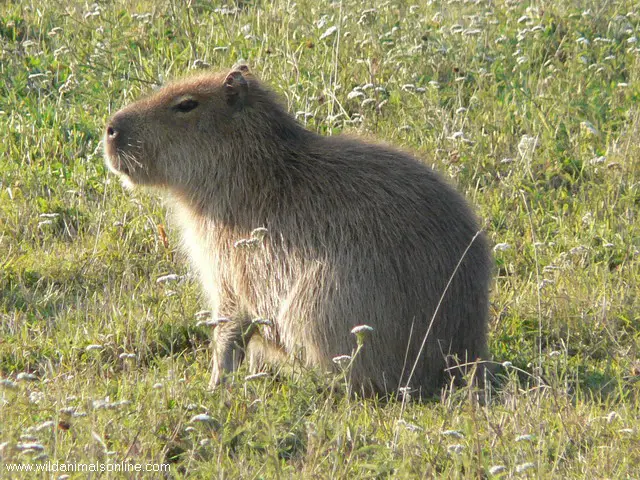Capybara
The capybara (Hydrochoerus hydrochaeris), also known as capibara, chiguire, and carpincho, is a big semi-aquatic rodent of South America. Capybaras have heavy, barrel-shaped bodies and short heads with reddish-brown fur on the upper part of their body that turns yellowish-brown underneath. It weighs just about 100 pounds and is about 2 feet tall at the shoulder. A full-grown capybara can reach a length of four feet (a bit over one meter). To help you imagine the size of a capybara, click on the image to the right to see a picture including a human being (5 ft. tall) for scale. This is the key reason why the capybara is placed in the undisputed position of the largest living rodent. The rodents are native to tropical South America, although they have been exported around the world for display in zoos and as pets and feral herds can be found in some parts of Florida. In South America, the animals are sometimes regarded as pests, due to their tendency to destroy vegetable crops, and some people also hunt them for food. Allegedly, the meat is reminiscent of pork, with a pale white appearance when cooked.

If looking deeply in its history, when this wonderful creature was found by the early Portuguese explorers, they adopted the animal’s name capibara from the native Tupi Indians. Capibara means “grass eater” a reference to the animal’s vegetarian diet, which was undoubtedly a subject of interest when capibaras were decimating vegetable crops. When the animals were formally classified as Hydrochoerus hydrochaeris, scientists chose to name the animal after its aquatic habitat of choice, rather than its dining habits.
Nonetheless, to a casual eyewitness, a capybara is similar to an oversized guinea pig. The animals are reddish brown with stumps for ears and tails, and short, blunt snouts. They also spend most of their lives in or around the water, and are quite athletic swimmers and divers. An adult capybara can stay underwater as long as five minutes, and the animals have been known to sleep underwater, keeping their nostrils above the surface like crocodiles.
Well-built, sturdy animals have a tendency to live in groups, although solitary individuals or pairs are sometimes observed in the wild. Given their affinity for water, some people call capybaras “water hogs.” Their skills in the water also make capybaras difficult to hunt and capture, since they readily escape to waterways when threatened.
The gestation period for capybaras is around 130 days. Mothers typically care for their young for several months, sometimes with the assistance of other female capybaras. The six to eight babies birthed by one capybara start out a creamy white, and darken in color as they mature. Given that the animals are extremely popular fodder for a range of jungle animals, they do not have a long life expectancy in the wild. Captive capybaras, on the other hand, have been known to live well over a decade.
Capybaras are really quite friendly and gentle, as a rule will allow humans to pet and hand-feed them. Capybara skin is tough, and thus in some areas where capybaras are wild, they are hunted for meat and their skin, which is turned into a high-quality leather, while some ranchers hunt them for fear of the competition for grazing. The meat is said to look and taste like pork. The Capybara meat is dried and salted, then shredded and seasoned. Considered a delicacy, it is often served with rice and plantains. During the Christian celebration of Lent, capybara meat is especially popular as it is claimed that the Catholic church, in a special dispensation, classified the animal as a fish in the 16th century. There are contradictory accounts of how the dispensation arose. The most cited refers to a group of 16th Century missionaries who made a request which implied that the semi-aquatic capybara might be a “fish” and also implied that there would be an issue with starvation if the animal wasn’t grouped as proper for lent.
